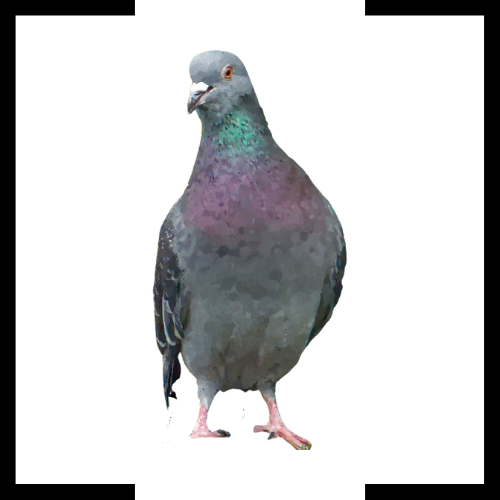Idaho, with its diverse landscapes and bustling city life, often attracts a variety of bird species that can become unwelcome guests in homes and businesses. These birds can pose serious problems, and dealing with them requires expert intervention.
Pigeons: The Unseen Menace
Pigeons have a storied history in urban environments, often seen as harmless city dwellers. However, they can quickly become a nuisance. They are easy to identify with their plump bodies, iridescent feathers around the neck, and a distinctive cooing sound. Pigeons are attracted to homes and businesses due to the abundance of food sources, nesting sites, and roosting spots. They often find their way into buildings through broken windows, vents, and open attics.
Signs of a problem include droppings on ledges, roofs, and sidewalks, as well as nests in hidden corners. While pigeons rarely attack humans, their droppings are a health hazard, carrying diseases such as histoplasmosis and cryptococcosis. Additionally, pigeon droppings are acidic and can cause significant property damage by corroding building materials. The smell from their droppings can be overpowering, creating sanitation issues. Pigeons can also attract other pests like mites and insects, further complicating the infestation.
Interestingly, pigeons have been used historically as messengers due to their homing ability, a trait that ironically makes them persistent pests when they choose a nesting site.
Sparrows: Small But Troublesome
Sparrows, though small, can create big problems for homeowners and businesses. These birds have a distinctive appearance with their brown and gray feathers and are known for their chirping. They are attracted to buildings for food and shelter, often entering through small openings in roofs, eaves, and vents. Sparrows are known to build nests in gutters, attics, and other hidden areas, causing blockages and damage.
Their presence is often indicated by their constant chirping and the sight of nests in gutters or eaves. Sparrows can carry diseases such as salmonella and can cause allergic reactions in sensitive individuals. Their droppings, like those of pigeons, can damage buildings and create unpleasant odors. Sparrows are not typically aggressive towards humans, but their nests can attract other pests, including insects and rodents.
Starlings: The Aggressive Invaders
Starlings are also commonly found in Idaho. These birds are easily recognized by their dark, iridescent feathers and speckled appearance. Starlings are known for their aggressive behavior, often driving away other bird species and taking over nesting sites. They are attracted to buildings for the same reasons as other birds: food, water, and shelter, and typically enter through gaps in roofs, vents, and chimneys.
Signs of an infestation include large flocks around a property, nests in vents or attics, and significant amounts of droppings. Starlings can attack humans if they feel threatened, particularly during nesting season. They also carry diseases such as histoplasmosis and can cause severe allergic reactions.
They are known for their ability to mimic sounds, including human speech and car alarms, adding to their nuisance factor.
Woodpeckers: Nature's Drummers
Woodpeckers, while fascinating to watch in the wild, can cause significant headaches for property owners. These birds are known for their distinctive pecking behavior, which they use to find food and create nesting sites. Woodpeckers have a striking appearance with their colorful plumage and strong beaks. They are attracted to homes with wooden siding, cedar shakes, and other materials they can peck into.
They typically gain access to homes by drilling holes in exterior walls, eaves, and siding. Signs of a problem include hearing their drumming, finding small holes in wooden structures, and noticing wood shavings on the ground. Although woodpeckers do not generally attack humans, their pecking can cause significant property damage, structural issues, and provide entry points for other pests.
Woodpeckers do not carry diseases harmful to humans, but their pecking can create extensive repair costs. The noise from their drumming can also be quite disruptive. A common misconception is that they only peck to find insects, but they also drum to mark territory and attract mates. An interesting fact about woodpeckers is that they have a specialized skull structure that protects their brain from the impact of pecking.
The Perils Of DIY Bird Control
While it might be tempting to tackle this problem on your own, DIY methods often fall short and can even exacerbate the problem. Many homeowners try using scare tactics, repellents, or traps, but these methods are typically ineffective and can lead to recurring infestations. Furthermore, handling birds and their droppings poses significant health risks, including exposure to diseases and parasites.
Improper removal techniques can also result in safety hazards, such as falls from ladders or exposure to hazardous materials. Additionally, certain bird control methods may be illegal, potentially leading to fines and legal issues. Professional wildlife control companies have the expertise and tools to address bird problems humanely and effectively, ensuring long-term solutions and peace of mind.
Don't let nuisance birds take over your home or business. Trust Agricole Wildlife Solutions for expert bird control services. Our professional team can provide responsible, effective, and humane solutions to keep your property bird-free. Contact us today to schedule an inspection.
Frequently Asked Questions About Nuisance Birds
Q1. Why do starlings mimic sounds, including human speech?
A1. Starlings are excellent mimics and can imitate a wide range of sounds, including human speech, car alarms, and other birds. This mimicry is believed to be a way to demonstrate their fitness to potential mates. A male starling with a diverse repertoire of sounds can attract more females by showcasing its learning ability and adaptability.
Q2. Can they really use tools?
A2. Yes, some birds, such as crows and woodpecker finches, are known for their tool-using abilities. They can use sticks, leaves, and even their own feathers to extract insects from tree bark or crevices. This level of problem-solving and tool use demonstrates their remarkable intelligence and adaptability.
Q3. Why do some build multiple nests but only use one?
A3. Birds like wrens and certain types of sparrows often build multiple nests to confuse predators and competitors. This behavior, known as "dummy nesting," helps protect their eggs and young by making it harder for predators to locate the active nest. It's a clever survival strategy that increases the chances of their offspring's survival.


